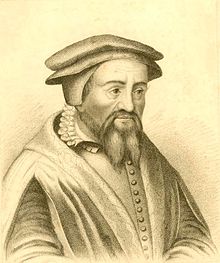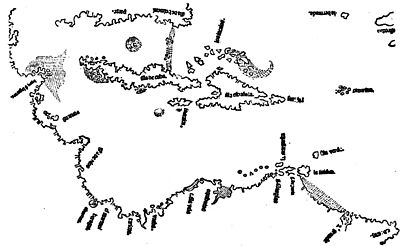- Peter Martyr d'Anghiera
-
For other people called Peter Martyr, see Peter Martyr (disambiguation).
 Frontispiece of De orbo novo
Frontispiece of De orbo novoPeter Martyr d'Anghiera (in Italian, Pietro Martire d'Anghiera; in Spanish Pedro Mártir de Anglería, Latin, Petrus Martyr Anglerius or ab Angleria) (February 2, 1457 – Granada, Spain, as a teacher of the nobility, October 1526) was an Italian-born historian of Spain and its discoveries during the Age of Exploration. He wrote the first accounts of explorations in Central and South America in a series of letters and reports, grouped in the original Latin publications of 1511 to 1530 into sets of ten chapters called "decades."
His Decades are of great value in the history of geography and discovery. His De Orbe Novo (On the New World, 1530) describes the first contacts of Europeans and Native Americans, Native American civilizations in the Caribbean and North America, as well as Mesoamerica, and includes, for example, the first European reference to India rubber. It was first translated into English in 1555, and in a fuller version in 1912.
Contents
Life
Martyr was born at Lake Maggiore in Arona, Italy (near the city of Anghiera), and studied under Juan Borromeo, then the count of Arona. He went to Rome at the age of twenty, and met important men in the hierarchy of the Catholic Church. After meeting the Spanish ambassador in Rome, Martyr accompanied him to Zaragoza in August 1487. Martyr soon became a notable figure among the humanists of Spain. In 1488 he lectured in Salamanca on the invitation of the university. The new learning was supported by highly placed patrons in the society. Martyr would become chaplain to the court of Ferdinand and Isabella.
After 1492, Martyr's chief task was the education of young nobles at the Spanish court. In 1501 he was sent to Egypt on a diplomatic mission to dissuade the Sultan from taking vengeance on the Christians in Egypt and Palestine for the defeat of the Moors in Spain. He described his voyage through Egypt in the Legatio Babylonica, which was published in the 1511 edition of his Decades. Following the success of this mission, he received the title of maestro de los caballeros (master of knights).
In 1520 Martyr was given the post of chronicler (cronista) in the newly formed Council of the Indies, commissioned by Charles V, Holy Roman Emperor to describe what was occurring in the explorations of the New World. In 1523 Charles gave him the title of Count Palatine, and in 1524 called him once more into the Council of the Indies. Martyr was invested by Pope Clement VII, as proposed by Charles V, as Abbot of Jamaica. Although Martyr never visited the island, as abbot he directed construction of the first stone church there.
He died in Granada in 1526.
Works
As a chronicler, Martyr performed notable literary work. He collected documents and accounts from the discoverers as well as personally interviewing them. He learned from the letters of Christopher Columbus and made use of the reports of the Council of the Indies. He had a great grasp of geographical issues; he was the first European to realize the significance of the Gulf Stream.
In 1511, his publications included the first historical account of the Spanish discoveries: Opera, Legatio, Babylonica, Oceanidecas, Paemata, Epigrammata (Seville, 1511). The Decas consisted of ten reports, two of which Martyr had previously sent as letters describing the voyages of Columbus, to Cardinal Ascanius Sforza in 1493 and 1494. In 1501 Martyr, as requested by the Cardinal of Aragon, added eight chapters on the voyage of Columbus and the exploits of Martin Alonzo Pinzón. In 1511 he added a supplement giving an account of events from 1501 to 1511.
Jointly with this Decade, he published a narrative of his experiences in Egypt with a description of the inhabitants, their country, and history. By 1516 he had finished two other Decades:
- The first was devoted to the exploits of Alonso de Ojeda, Diego de Nicuesa, and Vasco Núñez de Balboa
- The second gave an account of Balboa's discovery of the Pacific Ocean, Columbus' fourth voyage, and the expeditions of Pedrarias Dávila.
- Three appeared together at Alcalá de Henares in 1516 under the title: De orbe novo decades cum Legatione Babylonica.
- The Enchiridion de nuper sub D. Carolo repertis insulis (Basle, 1521) was printed as the fourth Decade, describing the voyages of Francisco Hernández de Córdoba, Juan de Grijalva, and Hernán Cortés.
- The fifth Decade (1523) dealt with the conquest of Mexico and the circumnavigation of the world by Ferdinand Magellan.
- The sixth Decade (1524) gave an account of Dávila's discoveries on the west coast of America.
- The seventh Decade (1525) had collected descriptions of the customs of the natives in present-day South Carolina, including the "Testimony of Francisco de Chicora", a Native American taken captive there; as well as those of natives in Florida, Haiti, Cuba, and Darién.
- The eighth Decade (1525) told the story of the march of Cortés against Cristobal de Olid, (1488 - 1524).
In 1530 the eight Decades were published together for the first time at Alcalá. Later editions of single or of all the Decades appeared at Basel (1533), Cologne (1574), Paris (1587), and Madrid (1892). A German translation was published in Basle in 1582; an English version may be found in Arber, The first three English books on America (Birmingham, 1885); a French one by Gaffarel in Recueil de voyages et de documents pour servir à l'histoire de la Geographie (Paris, 1907).
Martyr also wrote the historical account, Opus epistolarum, although it was not edited or published until after his death. This collection consists of 812 letters to or from ecclesiastical dignitaries, generals, and statesmen of Spain and Italy, dealing with contemporary events, and especially with the history of Spain between 1487 and 1525. It was published first at Alcalá in 1530; a new edition was issued by the House of Elzevir at Amsterdam in 1670.
Editions
- Peter Martyr d'Anghiera, De orbe novo, translated from the Latin with notes and introduction by Francis Augustus MacNutt, New York: Putnam, 1912. 2 vols.
- Peter Martyr d'Anghiera, Decadas del nuevo mundo, 1944
- Petrus Martyr de Anghieria, Opera: Legatio Babylonica, De Orbe novo decades octo, Opus Epistolarum, Graz: Akademische Druck- U. Verlagsanstalt, 1966 ISBN 320100250X
References
- Hartig, Otto (1910). "Peter Martyr d'Anghiera". Catholic Encyclopedia. vol. IX (New Advent online reproduction ed.). New York: Robert Appleton and Company. http://www.newadvent.org/cathen/09740a.htm. Retrieved 2007-09-11.
- Lampin, Didier (n.d.). "Biographie des cartographes et hydrographes". La Martinique à la carte.... http://perso.orange.fr/cartes-martinique/biographie.htm. Retrieved 2007-09-11. (French)
- Martyr D'Anghiera, Peter (1912) [ca. 1504–1526]. De Orbe Novo, Volume 1. Francis MacNutt (trans.) (Project Gutenberg reproduction ed.). http://www.gutenberg.org/files/12425/12425-h/12425-h.htm. Retrieved 2007-09-11.
This article incorporates text from the 1913 Catholic Encyclopedia article "Peter Martyr d'Anghiera" by Otto Hartig, a publication now in the public domain.
Categories:- 1457 births
- 1526 deaths
- People from Arona
- Spanish historians
- Spanish diplomats
- Age of Discovery
- History of Hispaniola
- Chroniclers
- 16th-century historians
- Italian Mesoamericanists
- Historians of Mesoamerica
- 16th-century Mesoamericanists
Wikimedia Foundation. 2010.


